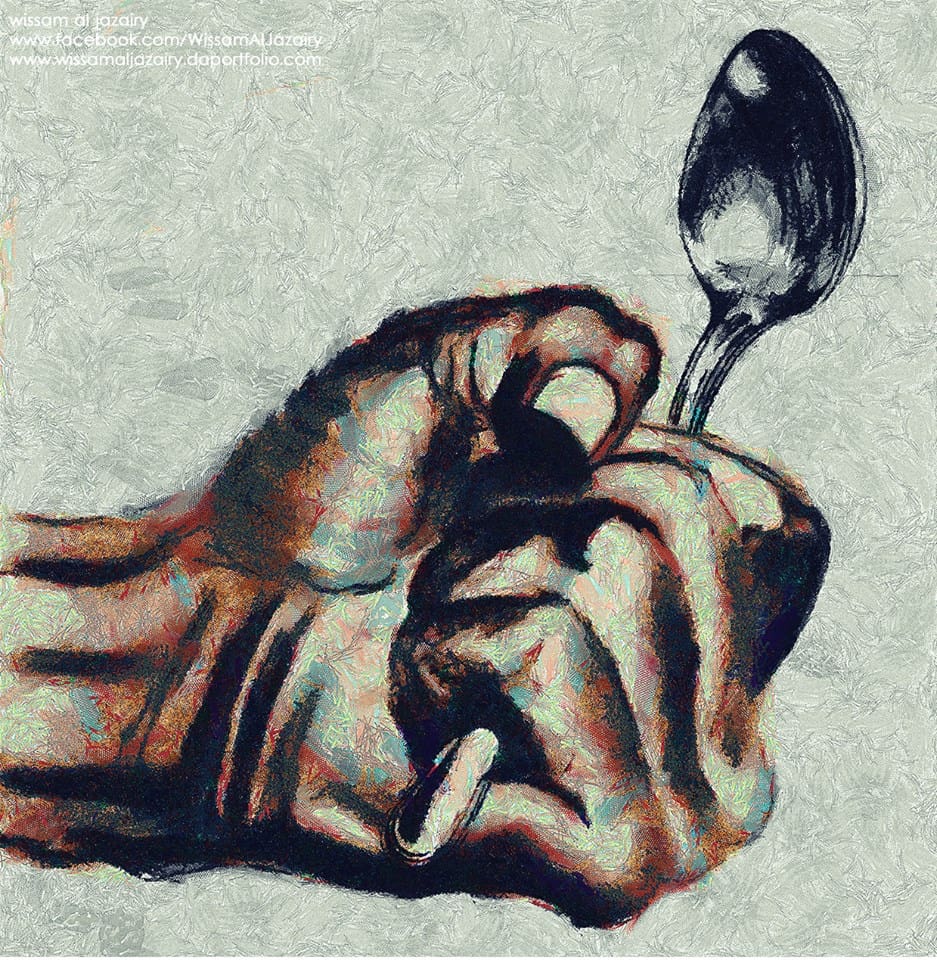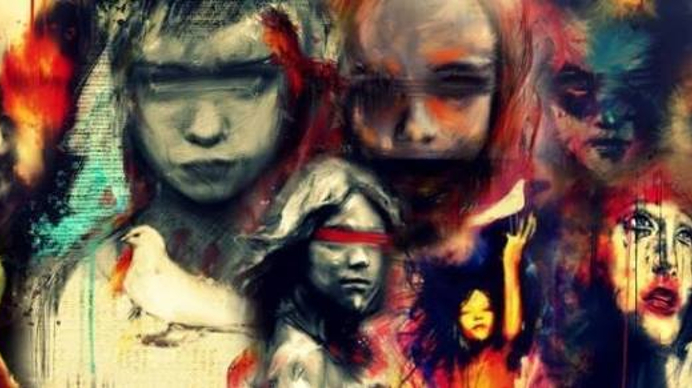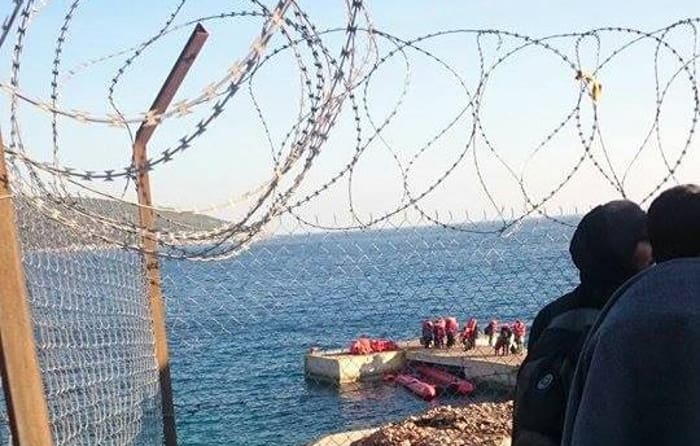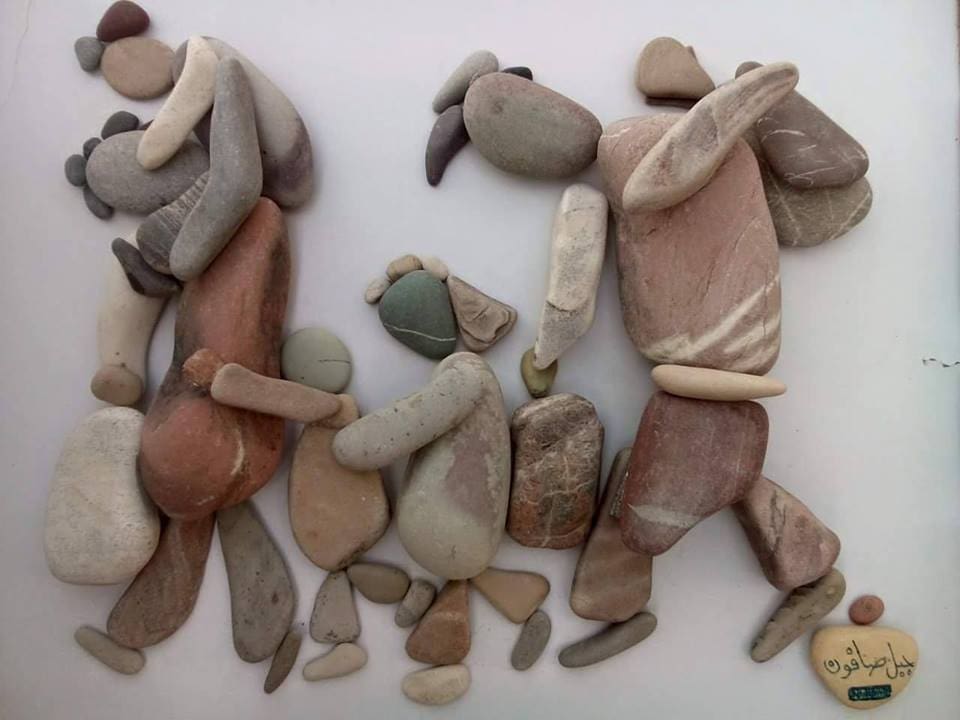Tel Al-Zaatar and Yarmouk refugee camp sieges, the similarities
by Tamim Al-Barghouti for Palestinian Pundit
27 February 2014 (original post)
The Yarmouk camp for Palestinian refugees in Damascus has been under siege for months, exposed to ground and air strikes, causing several of the refugees to die of starvation and resort to eating leaves and cacti, as well as the spread of intestinal and skin diseases due to the lack of clean water.
This has also resulted in the death of newborns, their mothers, the elderly, the ill and the wounded because of the shortage of medicine. Anyone trying to leave the camp is killed and the camp has been bombed numerous times.

Even when the Syrian regime allowed some aid to enter the camp, after pressure from foreign media, they restored the siege as soon as the pressure stopped or when the media attention is no longer present.
The attempts of Syrian regime supporters to deny responsibility for the camp are really sad. The Yarmouk camp is a neighborhood in Damascus. The legal, ethical, local and regional responsibility for the camp rests with the army who controls the city, the regime’s army.
Although supporters of the regime claim they have a cause or right, doing evil is a thousand times better than claiming to do evil in the name of a cause.
The Syrian regime has a long history of starving Palestinians, perhaps longer than any other Arab regime. Three of the four countries surrounding Palestine have been involved in the death of Palestinians once: September, Sabra and Shatila and the siege on Gaza, but only one country of the four were involved in the shedding of Palestinian blood three times: Tel Zaatar, the War of the Camps, and Yarmouk today.
On the three occasions, the scene is the same; the Syrian regime uses allied militias and orders them to surround the camp. In the case of Tel Al-Zaatar refugee camp in 1976, they used Maronite Lebanese Christian militias, consisting of the main Christian militia, the Phalangists, but also the Kataeb Forces, the Guardians of the Cedars and the Marada movement.
In the War of the Camps, between 1985 and 1988, the regime recruited the Shia Lebanese Amal Movement, which at the time was in armed conflict with Hezbollah over influence in Beirut and the south. Hezbollah did not participate in the War of the Camps, but the Amal movement opened fire on the Palestinians and Hezbollah at the same time.
As for today, the Syrian regime relies on the army directly, as well as some loyal Palestinian militias such as the Popular Front for the Liberation of Palestine – General Command and Fatah Al-Intifada.
On all three occasions, the water and electricity supplies were cut off from the camp, they were deprived of supplies and ran out of them, and people began to starve to death. On all three occasions, hunger drove the people to eat leaves and ask for fatwas to eat cats, dogs and dead animals; the women who walked to the working wells and water pumps on the outskirts of the camp were killed by snipers surrounding the camps.
According to the testimonies of Hussain Ayyad and Maysa Khatib, residents of Tel Al-Zaatar, the women who were shot by snipers fell into the wells and people were forced to use the wells while the martyrs’ bodies remained in them. They were unable to remove the bodies because snipers continued to shoot at them.
On all three occasions, the media was told that the level of hunger in the camps was a lie, that eyewitness accounts were delusions and that the hunger victims were hungry for fame. In all of these instances, the forces imposing the siege on the camps would eat and drink in front of the cameras of the news agencies on the outskirts of the camp, in order to further humiliate and insult the people.
One of the Lebanese television stations supporting the Syrian regime broadcasted a report on the Yarmouk refugee camp, showing the soldiers imposing the siege eating with one of the station’s correspondents and denying the fact that the people were hungry, while repeating scenes of spilled children’s milk during the sieges of the Sabra and Shatila and Burj El-Barajneh camps in the eighties, the former sieges imposed by Lebanon and backed by Israel and lasted three months, from June to September 1982. The latter siege was imposed by Lebanon and supported by Syria, lasting four years, from 1985 to 1988.
On all three occasions, the Syrian regime claimed it killed the Palestinians because they are radical and resistant, but they never clash with Israel, not even when they bombed the capital. In all three cases, humiliating the Palestinians in the media was an essential part of the war against them. This was not only to demoralize the people in the camps and those defending them under the siege, but also to distort the image of Palestine and the Palestinian political and cultural symbols and confuse the Syrian and Lebanese public opinion and reactions to such actions, or, at the very least, delay them from taking action to oppose the siege on the camps.
On 9 January 2014, UNRWA spokesperson Christopher Gunness said, “The profound civilian suffering in Yarmouk deepens, with reports of widespread malnutrition and the absence of medical care, including for those who have severe conflict-related injuries and women in childbirth, with fatal consequences for some women.”
Britain’s The Guardian reported the same UNRWA spokesperson saying, on 9 February 2014, a month after his first statement, that Dr. Ibrahim Mohammed, who works with UNRWA, saved the life of a fourteen-month-old baby boy named Khaled, who was suffering from severe malnutrition. The baby was living almost exclusively on water for two months. His mother, Noor, who is 29 years old, said that they would boil water and spices and eat it, and when they ran out, they started eating grass, but they even ran out of that too.

In a documented message from the Euro-Mediterranean Human Rights Network (EMHRN), an organization based in Geneva working in coordination with UNRWA to bring food into the camp, the EMHRN reported that a fifteen-year-old girl named Heba, along with her five-month old child, told the UN food distributors that they hadn’t eaten for three days and she has not been able to breastfeed her child. When the paramedics gave the baby water to drink, he became so bloated because he hadn’t had anything in his stomach for days that the paramedics were concerned for him and one of the Red Cross International doctors was summoned to treat the baby.
These instances of hunger were followed in the past by killings of anyone trying to leave the camp. In the case of Tel Al-Zaatar camp, for example, after starving the camp for months, the Phalangist militias, backed by the Syrian regime, announced that they would allow the Palestinians to leave in order for the Red Cross to transport them to their shelters. When the Palestinians started to leave the camp, the militiamen began killing the Palestinians, according to Maysa Al-Khatib, one of the survivors of the massacre whose testimony, along with Hussain Ayyad’s, was published in the Palestinian appendix to Lebanon’s Al-Safir newspaper on 12 August 2013 and 15 September 2012.
“A massacre was committed against every young man and boy over the age of ten who tried to leave the camp, as well as dozens of girls, women, and the elderly. A woman carrying her two-day-old baby was approached by one of the murders, who grabbed her baby and threw him far away; he fell onto some trees and she was unable to see where his body landed.”
“A young woman with wounded legs was crawling through the crowds and one of the killers told another, ‘Take her under the fig tree and make her happy.’ She said: ‘Death is a thousand times better,’ so he said, ‘Then die,’ and shot her.”
“Ghazi, my cousin, was carrying my grandmother on his shoulders, thinking that carrying her would save her from death and they killed her before they killed him. An old woman slipped and fell into a ditch and while she tried to climb out of it, one of the killers said, ‘Where are you going? Stay where you are’ and he shot her in the head several times.”
“Abu Yaseen Freijah, an UNRWA nurse, was dressed in his white uniform and was holding his wife, who was shot in the shoulder and the killers snatched his wife away from him, tied his legs to two cars, and they drove off in opposite directions.”
“My seventeen-year-old cousin Ali, who was meek and harmless, was tied to the back of a car that set off at full speed onto the asphalt. Abu Akram, the well-known textiles seller, tried to stop the killers from taking his son by giving them all the money in his possession, but they killed his son in front of him before shooting him and they picked up the money he threw.”
Those who committed the Tel Al-Zaatar massacre and starved the people during the War of the Camps have not been punished to this day and some have even gone on to become ministers and heads of representative councils in Lebanon and leaders in Syria. These tragedies are being repeated in Yarmouk refugee camp. Although the beginning of the tragedies in Yarmouk is similar to the ones in Tel Al-Zaatar, we must all take action in order for them not to end in the same manner.

Tamim Al-Barghouti is a Palestinian poet and political scientist. Al-Barghouti comes from a literary family. His father is the Palestinian poet Mourid Barghouti, and his mother is the Egyptian novelist and scholar Radwa Ashour. This article is a translation of the Arabic text published by Shorouk newspaper on 25 February 2014.
Featured image: “Martyr’s Grip” by Wissam Al Jazairy





